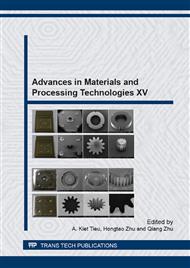p.377
p.392
p.400
p.409
p.414
p.420
p.429
p.437
p.448
Design, Fabrication and Properties of Textured Self-Lubricated Tools in Dry Cutting
Abstract:
Textured self-lubricated tools were designed and fabricated. Dry cutting tests were carried out on with these self-lubricated tools and a conventional tool. The tool wear and the friction coefficient at the tool chip interface were measured. It was shown that the tool wear and the friction coefficient of the textured self-lubricated tools were reduced compared with that of the conventional tool. Two mechanisms responsible were found, the first one is explained as the formation of a lubricating film with low shear strength at the tool-chip interface, which was released from the texturing and smeared on the rake face, and served as lubricating additive during dry cutting; the other one was explained by the reduced contact length at the tool-chip interface of the textured tools, which contributes to the decrease of the direct contact area between the chip and rake face. It is suggested that the using of textured self-lubricated tools is an effective way to reduce the tool wear in dry cutting.
Info:
Periodical:
Pages:
414-419
Citation:
Online since:
November 2013
Authors:
Keywords:
Price:
Сopyright:
© 2014 Trans Tech Publications Ltd. All Rights Reserved
Share:
Citation:


